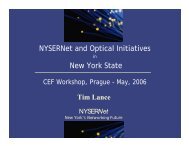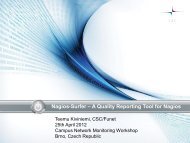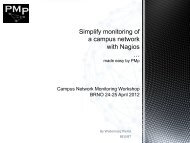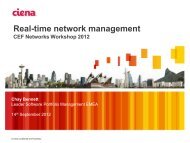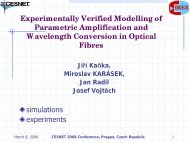2002 - cesnet
2002 - cesnet
2002 - cesnet
Create successful ePaper yourself
Turn your PDF publications into a flip-book with our unique Google optimized e-Paper software.
int size=2097152;setsockopt(sock, SOL_SOCKET, SO_RCVBUF, (char *)&size, sizeof(int));setsockopt(sock, SOL_SOCKET, SO_SNDBUF, (char *)&size, sizeof(int));The advantage of a manual setup for all TCP connections on the operating systemlevel is that it works with every application, without any need to modify it.On the other hand, wasting memory is a disadvantage, as only some TCP connectionsactually need large buffer memory. An example is again given for theLinux OS, the values indicate the minimum, standard, and maximum size of thebuffer, which the operating system allocates to individual connection accordingto heuristics, based on the actual memory consumption and other configurationparameters (an example for an initial setup of 2 MB):sysctl -w net/ipv4/tcp_rmem=”4096 2097152 8388608”sysctl -w net/ipv4/tcp_wmem=”4096 2097152 8388608”It is obvious that this solution is almost unacceptable for a server with hundredsof active TCP connections. For more or less automatic configuration for individualTCP connections, there are several alternative extensions of the operatingsystem kernel, in the form of patches or auxiliary daemons, developed as partof special projects. These mechanisms are now being further developed.Unfortunately, increasing the buffer memory and the sender window is notenough to ensure reliable and high throughputs in large high-speed networks.It is necessary to adjust the algorithm of congestion control at the sender, andanalyse and solve a number of phenomena encountered during high-speedtransmissions.We are now intensively working on these issues. Some of the phenomena canbe analysed by analysing the packet flows, recorded by the tcpdump program.Data are analysed by the tcptrace program after the connection is terminated.Another possibility is a real-time analysis of state variables maintained by theweb100 kernel extension.We created several scripts for the correlation of information acquired fromthese two sources. For instance, the diagram in Figure 9.13 shows the developmentof rwnd (upper part of the diagram), acquired from the data flow tracedby tcpdump and the development of cwnd (lower part of the diagram), acquiredthrough the programming interface to the web100 extension. The figure showsrwnd window moderated by the TCP receiver in Linux in order to prevent networkcongestion with sudden data bursts from the sending application. Thesender carries out similar moderation with its cwnd calculated window.It is also useful to estimate the available bandwidth of the route. The tools forthese purposes are the subject of active research. As an example, there are thepathload and ABwE programs. Further outcome will be presented during thePFLDnet 2003 conference at the beginning of the next year.132 High-speed National Research Network and its New Applications <strong>2002</strong>





